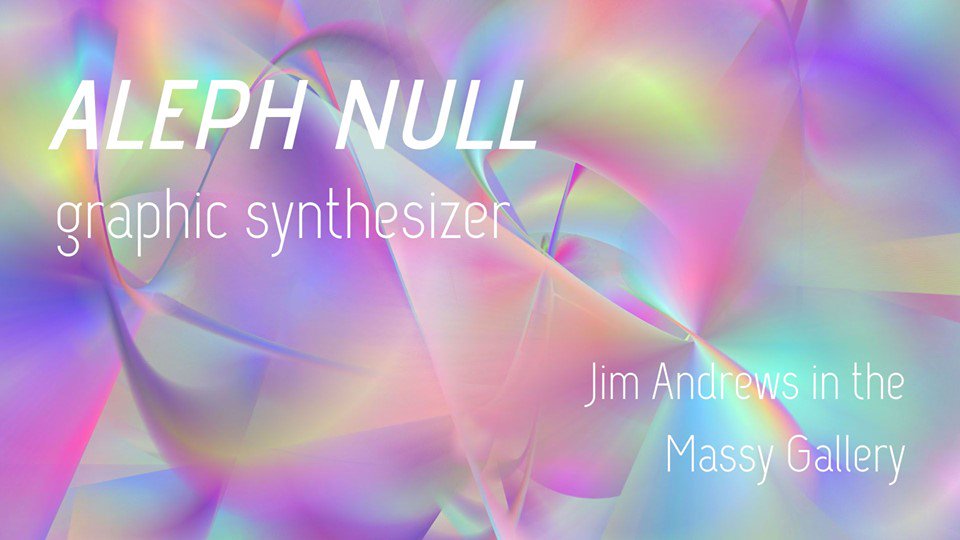
<!– Thoughts on resolution and the impossible task of selecting one of many from a randomly generated set of screens. –>
Aleph Null, Graphic Synthesizer, by net-artist : e-poet : programmer : ++ Jim Andrews is a software tool, a never ending project, and a series of collaborations with other artists. Its most recent configuration is as a series of digital prints, occupying ‘real’ space —still images, presented in a fine art photographic tradition. By ‘real’ I mean in a gallery* with walls of course. As opposed to the multitude of digital screens it could occupy, while it rests in stand-by mode until “Play” or “Run” is pressed.
One of the elements which intrigues me about this project is the contrast between the screen and the print, and the implications there-in. On the screen as something plays, or is played with, the visual result is never static. You can actively participate and create your own images that it, as Jim states “chews on”, obliterating, morphing, altering them depending on the “brush” you choose. Once it starts doing this mastication, it tends to invoke a kind of meditative state, as you watch or interact with the slideshow. You may agree or disagree with its aesthetic . Aleph Null is seemingly neutral, indifferent to your tastes, as it randomly generates another and another sequence … no two are ever the same.
I tried plugging in some of my cat drawings (my secret vice) and was surprised by the outcome. For what it showed me, because of way the brush I selected cropped, re-worked, and blended my drawings, was to notice the gestural nature of the brushwork / line I am most inclined to use. I hadn’t previously thought of them as expressionistic and yet this emphasized that aspect. It provoked me into thinking about how I might deliberately alter some of the images (digitally or old-school collage) to highlight something I had not previously noticed, but that evidently is intrinsic to the images. If you are a poet, like bill bisset or Jim Leftwich, I’m guessing the effect on your perception of your work is different — as it is words that are being chopped, streamed, re-configured, broken. A mashup of text being eaten and digested.
Resolution and Running
Screens seem to be getting increasingly lush these days, with tablets and phones boasting of 1792 x 828 / 2048 x 2732 pixels. The exactness of the numbers no doubt has meaning, but feels curious.
A typical computer monitor resolution – on the internet ranges from 1920 x 1080 to 2560 x 1440 to infinity (?) at a paltry 72 ppi (or something close in windows). Ppi is pixels per inch. In other words, pretty low rez and if you’ve ever tried to print a jpg saved for web, you’re aware how quickly the image gets pixelated and generates artefacts.
I have only seen one of Andrew’s print so far — as I write this the show hasn’t opened yet — but Jim told me he is able to capture the generated images as a still capable of being printed at ~3 feet wide without any loss of clarity. 12,000 pixels.
Chew on that number for a moment.
These generated and yet carefully selected prints, face-mounted and backed with aluminium, are the antithesis of the fleeting and random space of Aleph Null on screen. They offer a contemplative reflection into the nature of text, collaboration, colour and play.

*Aleph Null is at Massy Books (229 E. Georgia St. Vancouver) in the gallery upstairs. It runs from October 25th – Nov 20th, 2019.
Jim Andrew’s projects are housed at vispo.com.
Post Opening / Vernissage Mini Notes
Aleph Null – Learned that the title is a tribute / nod to mathematician’s Georg Cantor’s proofs.
The prints that are collaborations with bill bissett have a grittier / sixties aesthetic to them, where the resolution doesn’t play as much of a role in their reading.
Thanks, Deanne. Nico Vassilakis, like you, noted that seeing his own work in Aleph Null allowed him to see his own work from a perspective he hadn’t seen it from before, and thereby allowed him to see things about it he hadn’t seen before, or not in the same way.
One of the things it does is put different works in new relation with one another. It creates new works as assemblages of several others.
But you saw something else in it. It highlighted the gestural in your work, to you. If I were a betting man, I would wager that is because it connects or juxtaposes or synthesizes different images, thereby obliterating the careful kitty shapes, perhaps, and decomposing them into their parts, which are evidently gestural brushstrokes–the images are made of brushstrokes–your brushstrokes–but Aleph Null has its own brushstrokes also, which obliterate the shapes inside your images but create larger assemblages that seem to be more evidently decomposed into *your* brushstrokes.
🙂 Yes. This question of “your” brushstrokes ie>> ownership / authorship comes up too of course. Next time I’ll take screenshots. Cheers
A tangled tale, no doubt.